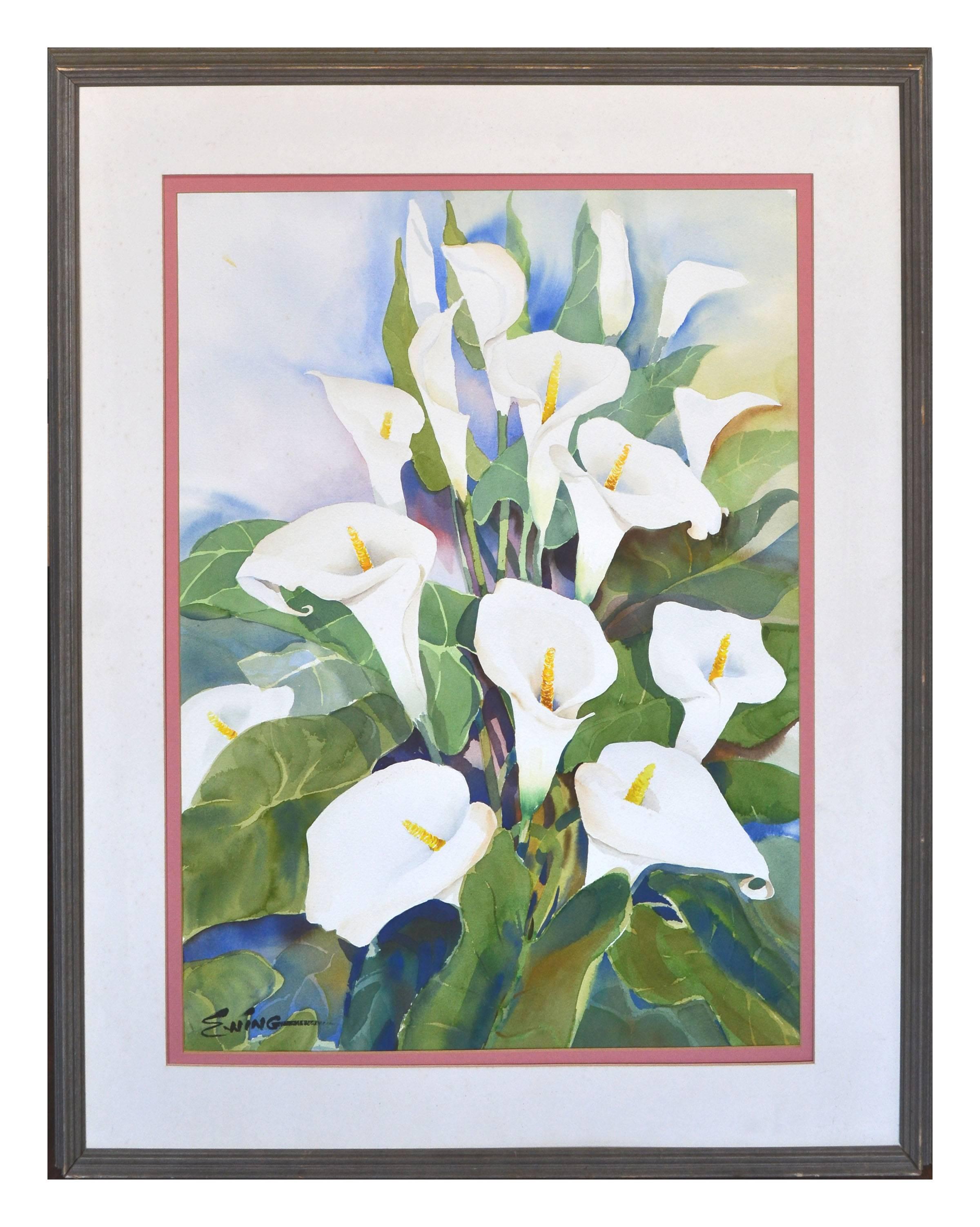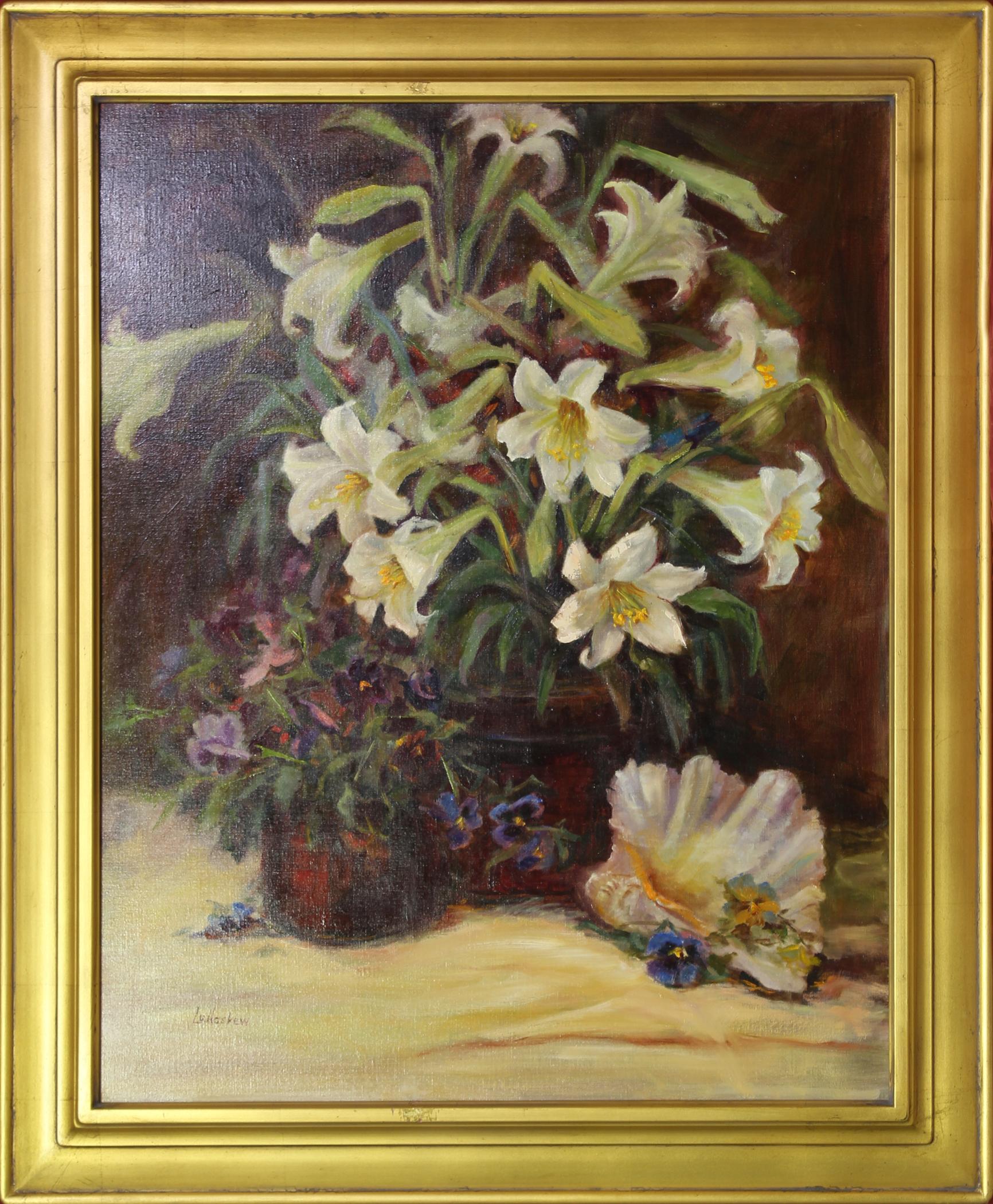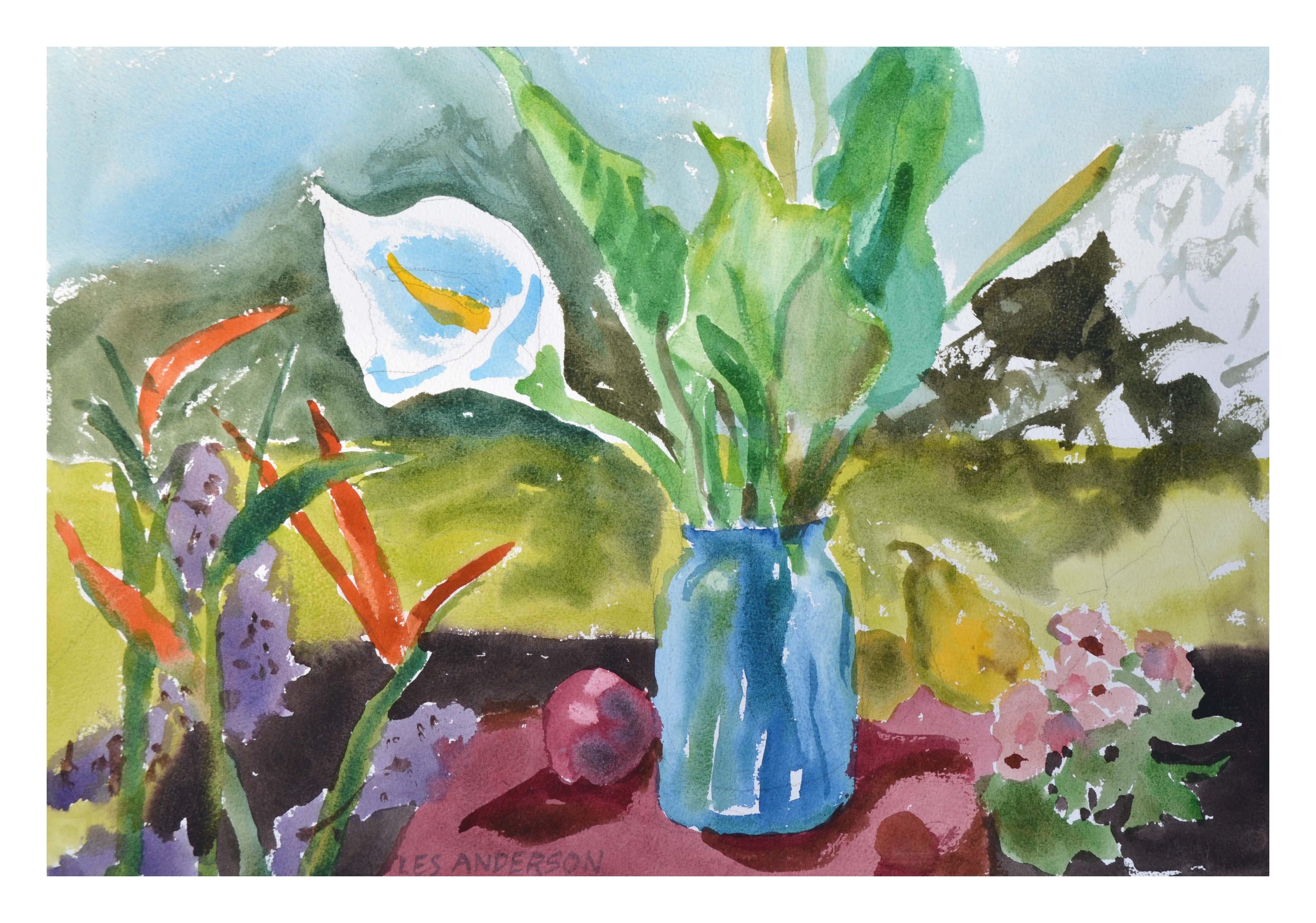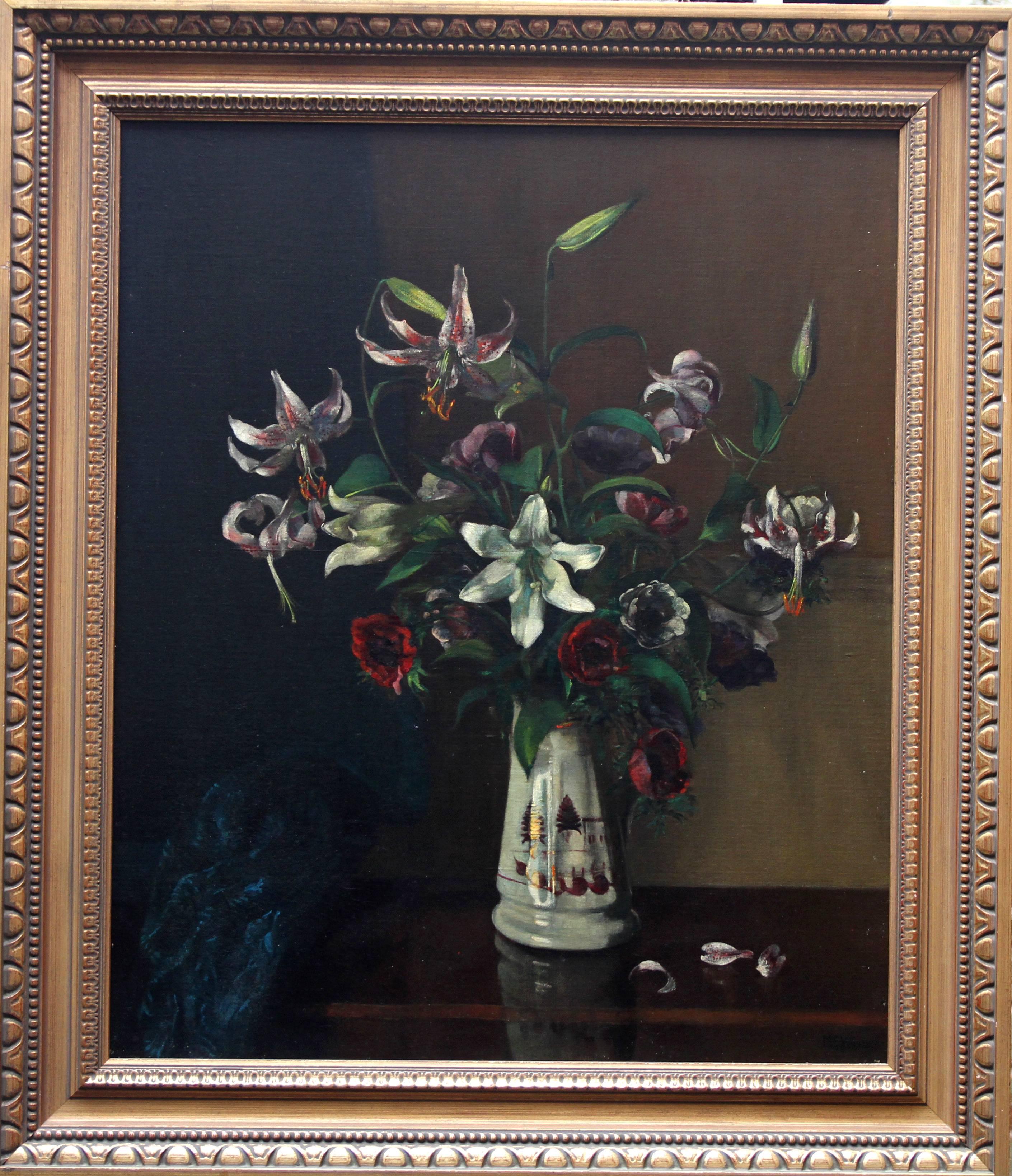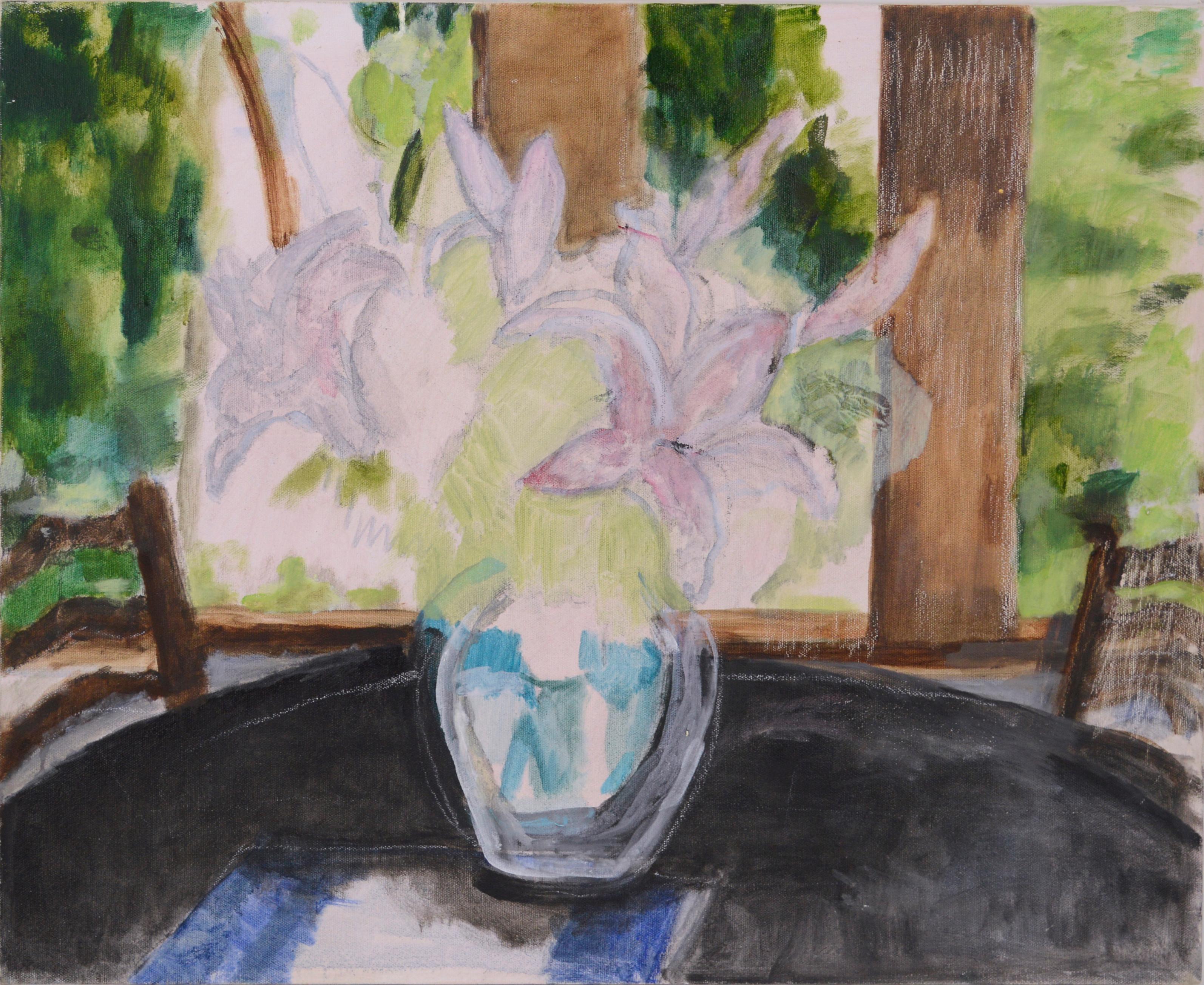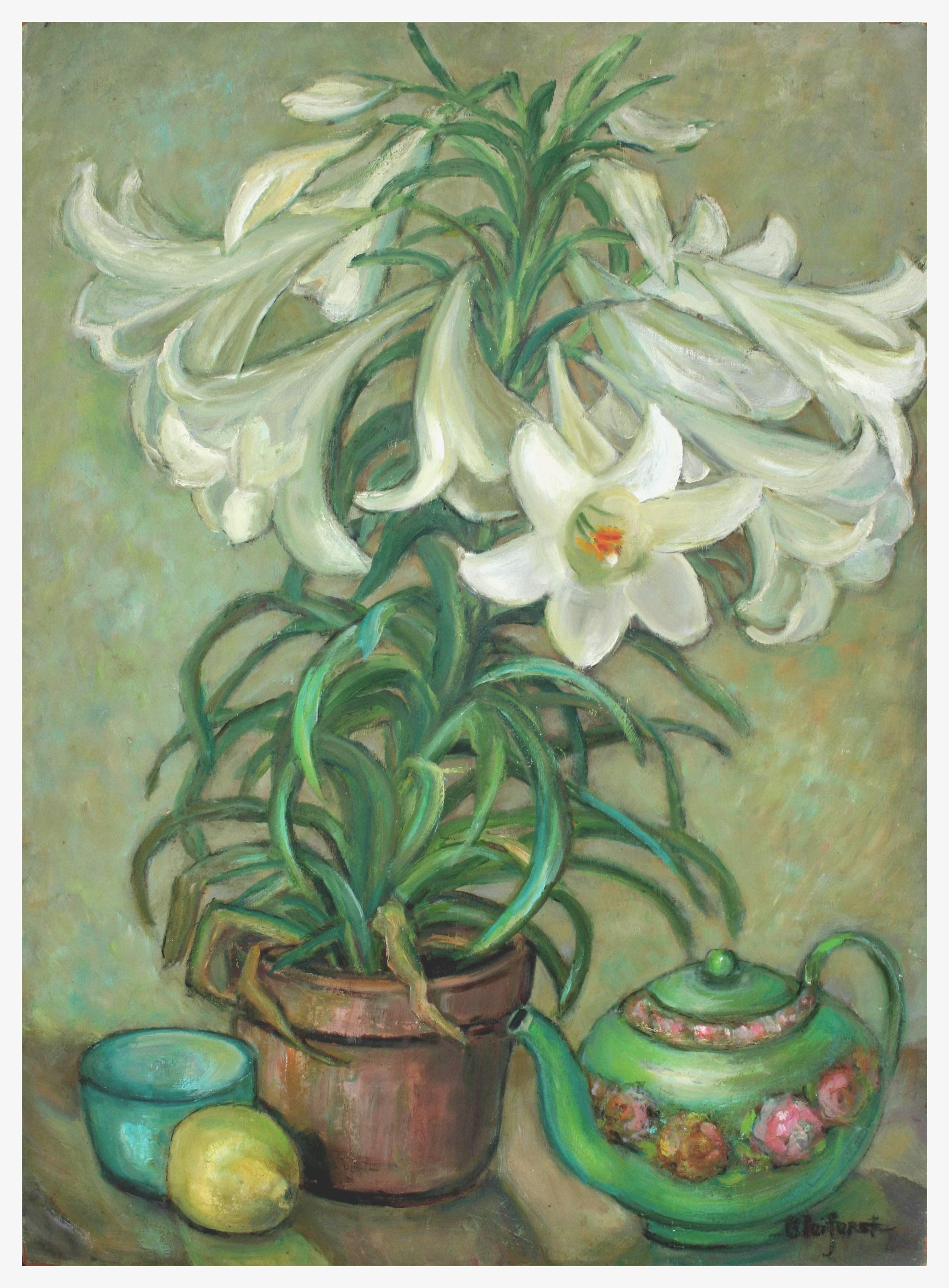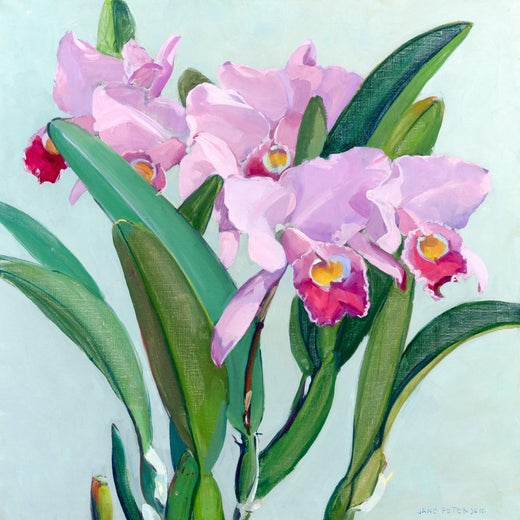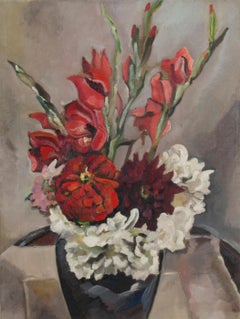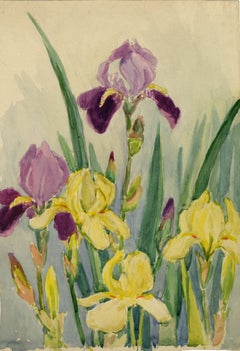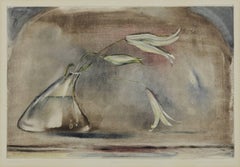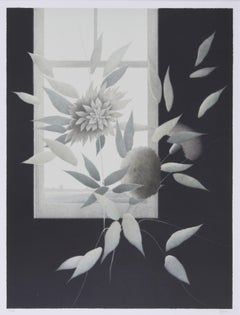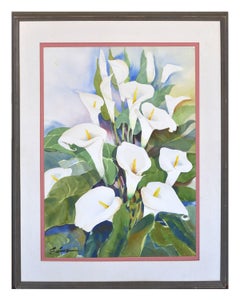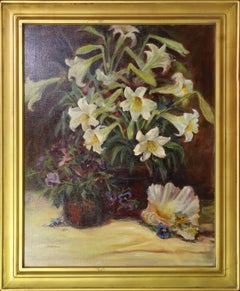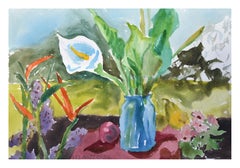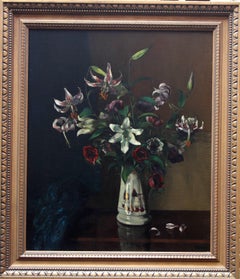Items Similar to Lilies
Want more images or videos?
Request additional images or videos from the seller
1 of 11
Jane PetersonLilies
$24,000
£18,098.38
€20,931.65
CA$33,671.87
A$37,428.38
CHF 19,619.15
MX$457,091.05
NOK 244,933.81
SEK 230,437.02
DKK 156,227.74
About the Item
Jane Peterson (1876-1965)
Lilies
Oil on canvas, 1952-1953
Signed by the artist lower right: JANE PETERSON
(see photo)
Painting size: 29 x 23 inches
Frame size: 38 x 32-1/2 x 1-1/2 inches
Exhibited: The Pennsylvania Academy of the Fine Arts: One Hundred and Forty Eighth Exhibition of American Painting and Sculptures, January 25-March 1, 1953
(Photo of original label). Original tacks on stretcher where label was afixed. Label stolen while on exhibition.
Exhibited: Childs Gallery, Boston, 2019- 2023
Jane Peterson was an artist who achieved significant critical attention and adulation over the course of her career. Following her first American solo exhibition in 1909, a critic observed, “There is not a dull canvas in the entire collection and everything is interesting”.1 Thirty-five years later, Historical Records published her biography in the almanac Prominent Women of New York.2 Regardless of her success, Peterson remained pragmatic as she always sought to challenge herself with new ideas and techniques. She spent a lifetime immersed in the practice of painting; as a student, teacher, and gifted artist.
Peterson was a painter with little interest in self-promotion or the conventional achievements of an artist, as a result there has only been a moderate body of scholarship written about her posthumously. Peterson’s legacy is her brilliant oeuvre of impressionistic paintings, held by collections such as the Metropolitan Museum of Art, the Philadelphia Museum of Art, and the Brooklyn Museum of Art.
"Jennie Christine Peterson was born in Elgin, Illinois in 1876. From an early age Peterson, who was known throughout her life as Jane, showed a natural talent for drawing. As a teenager, having received no formal art training, Peterson sat the art aptitude test conducted by the Pratt Institute. The results were promising and, in 1895, Peterson moved to New York to study at the Pratt Institute in Brooklyn.
Peterson thrived at Pratt as a conscientious student, although it was not an easy time for her financially. When her money ran low Peterson gave art lessons to other students, and also earned some income through the sale of her paintings in student exhibitions. When Peterson graduated in 1901, she began working as Drawing Supervisor of Public Schools in Brooklyn. She also continued her art education taking classes at the Art Students League. Between 1904 and 1906 Peterson worked as an art teacher in New York, Massachusetts, and Maryland. In 1907, Peterson sailed to Europe where she visited artists and museums in France, Holland, and Italy. She found Europe to be more socially progressive for women artists and decided to stay and continue her art education.
While in Europe, Peterson studied under Frank Brangwyn at the London School of Art, before relocating to Paris where she received instruction from Jacque-Emile Blanche, Charles Cottet, and Claudio Castelucho. Throughout 1908, Peterson was extremely productive, creating many works in her spare time while also taking on portrait commissions to augment her income. She lived in rooms in Montparnasse located around the corner from Gertrude Stein’s salon, where on Saturday evening artists and art enthusiasts would gather to view and discuss Stein’s seminal collection of Modern art. Attending these events Peterson surrounded herself with powerful art luminaries such as Pablo Picasso, Henri Matisse, Georges Braque, André Derain, and Henri Rousseau.
Peterson’s style from this period is neither entirely academic nor avant garde. Rather she blends the technical skills of her academic training with the loose brushwork and bold color palette of her contemporaries to produce paintings that are beautiful impressions of life. Peterson’s early oil paintings from Europe often show flat generalized areas of color contrasted with skilled detailing – brickwork, window frames, clothes, etc. – that perfectly conjure a scene.
While in Paris, Peterson exhibited her work at the Société des Artistes Français. Then, in 1909, she had her first American exhibition at the Botolph Club, Boston. Favorable reviews ensured this exhibition marked a decisive point in her career, as she shifted from diligent student into the role of a mature artist. However, despite her success Peterson’s single-minded passion for painting kept her open to experimentation new techniques, as she considered perpetual learning and re-learning to be essential practices for an artist. Following two more successful solo exhibitions in 1909, Peterson returned to Europe where she commenced studying with the acclaimed Spanish artist Joaquín Sorolla y Bastida in Madrid.
Of all her teachers, Sorolla had the most influence upon Peterson’s style. Sunlight-drenched Spanish scenes characterize Sorolla’s works. After 1909, Peterson’s canvases become more daring with color, as layers of loose brushstrokes combine to represent the shimmer of Summer’s light in southern Europe. In 1910, Peterson travelled alone to Egypt and Algiers – an extremely brave move for a woman in the early 20th century – where she did a series of paintings in her new bold style. These works were exhibited later that year in a solo exhibition at the Art Institute of Chicago.
In 1911, Louis Comfort Tiffany invited Peterson to his estate, Laurelton Hall, in Oyster Bay, Long Island. Peterson remained at Laurelton for many months, painting the estate’s magnificent gardens. Her love for nature, particularly flowers, would become a subject matter that would increasingly occupy her work. She stated later in life, “I adore gardens! They are the most elusive art of a nation.”3 After 1912, Peterson worked increasingly with gouache as the medium allowed her more freedom for painting en plein air and experimenting with quick strokes of color. She often combined charcoal with gouache, as drawing details with charcoal allowed Peterson to be even more free and light with her paint. Between 1913 and 1919 Peterson worked as a watercolor instructor at the Art Students League.
During the 1910s and 1920s Peterson continued to travel extensively overseas, taking solo painting trips to France and Turkey. Closer to home, she visited Canada, Alaska, California, Florida, and the states of New England. As a result of her adventures around the globe, many of Peterson’s subjects are quite internationally debonair and socially minded in an era when many women favored painting domestic scenes of women and children. For example, during World War One, Peterson joined the war effort painting military portraits and patriotic scenes of women rolling bandages and folding blankets at the Red Cross Center. Spending six months in Turkey in 1924, she painted streets scenes in the Islamic cities of Constantinople and Broosa.
In 1925, Peterson married Moritz Bernard Philipp, a successful corporate lawyer. The couple moved to five-story home on Fifth Avenue in New York City, directly opposite the Metropolitan Museum of Art. A sixth story was added to their home to be Peterson’s studio. After her marriage Peterson focused on flower painting, a subject that would occupy her practice for the rest of her life. She explains:
[Flowers] scintillate the prismatic hues of the rainbow; they harmonize the pastel shades of the night; they are all that is delicate; all that is lurid, brilliant, bizarre. They are living things with personality and refinement, with delicacy of form and structure, with variety of size and shape, with rhythm and charm of arrangement, with grace and dignity of bearing.4
Peterson approached flower subjects with the same intense single-minded passion that drove her to travel solo around the world. She analyzed flowers as mysterious objects of beauty that required diligent attention and sensitive expression. Flowers were by no means an undemanding subject for Peterson.
After Philipp died in 1929, Peterson continued to travel frequently. Throughout the 1930s and 1940s she often spent Summer in Europe, Fall and Spring in New York, and Winter in Palm Beach, Florida. In 1938, she studied with the Modernist André Lhote in Paris. During this time Peterson continued to paint her ‘flower portraits’, and she had numerous exhibitions in New York and Florida.
By the mid-1950s arthritis had affected Peterson’s hands so badly that she could only paint occasionally. Peterson spent the last five years of her life living with her niece in Kansas. She died in 1965.
Since Peterson’s death, her works continue to be highly coveted by collectors. This is due partially to her artistic oeuvre not fitting neatly into a single movement of art history. Peterson’s love for painting floral arrangements is not consistent with her contemporaries’ ideas of the avant-garde. However, while Peterson painted gardens, town squares, and beach scenes in an impressionistic representational style, she was also – like her Modernist peers – pushing the boundaries of an accepted norm. Peterson’s biography is a testament to her passionate, and very determined quest to depict beauty. She persevered against the conventions of her modest upbringing to establish a career as an artist, and she preserved against the conventions of her gender to establish herself as an independent and internationally experienced artist. As a result, Peterson’s flower portraits and international landscapes are a tribute to her adventuresome spirit and resolve to capture elusive beauty on canvas." Courtesy Questroyal Fine Art
- Creator:Jane Peterson (1876-1965, American)
- Dimensions:Height: 29 in (73.66 cm)Width: 23 in (58.42 cm)
- Medium:
- Movement & Style:
- Period:
- Condition:
- Gallery Location:Fairlawn, OH
- Reference Number:Seller: FA68031stDibs: LU14015959672
Jane Peterson
Jane Peterson's most innovative period was from 1910 to 1930. During this time she produced her most important work. Her trips to Venice resulted in exuberant paintings full of glowing color. This painting is from that period. The brushwork is bold and exciting. The bright round yellow carob flowers contrast with the vertical mauve carob pods. The trunks and branches of the trees form a series of triangles that reflect the lush Mediterranean landscape. Originally the painting was sold in Paris to an American collector. Jane Peterson was a leading woman post-impressionist painter of the early 20th century. Born in Elgin, Illinois, on November 28, 1876, she was interested in art throughout her childhood. In 1895, she went to New York City to study art at Pratt Institute. Before graduating in 1901, Peterson taught painting and became a popular teacher at Pratt. She then became the Drawing Supervisor of Brooklyn Public Schools. She studied oil painting with Frank Vincent DuMond who emphasized a prismatic palette. Subsequently, she studied painting with Frank Brangwyn in London, Jacques Emile Blanche and André Lhote in Paris, and Joaquín Sorolla y Bastida in Madrid. She was influenced by Impressionism and Fauvism during her studies in Paris. In 1924, Peterson's painting, Toilette, received critical acclaim at the New York Society of Painters. Her one-woman show on Fifth Avenue sold out. By this time, she had won numerous awards, was a Fellow at the National Academy of Design, and a member of many art clubs including the American Watercolor Society, Audubon Artists, Pen & Brush Club, and the National Association of Women Artists. In 1925, The New York Times characterized Peterson as "one of the foremost women painters in New York." Known for her colorful, post-impressionistic paintings of Gloucester streets and harbor on Cape Ann; palm trees along the Florida coast; street scenes in Paris, Istanbul, and New York City; and boating views in Venice. Peterson also flamboyantly executed floral subjects and dynamic genre-like portraits. Carob Tree (Ceratonia siliqua) is a small evergreen tree of the Mediterranean coasts. It has dark green, compound leaves with glossy, oval leaflets. In Italy, the carob tree blooms from September to November. Its seedpods, also known as Saint John's bread, are up to 45 centimeters long and are filled with round, hard seeds and a thick pulp. St. John's Bread was probably the husks in the Prodigal Son parable and the seed which is said to have been the original jewelers' carat weight. The Spaniards call it Algaroba, and the Arabs Kharoub, hence Carob or Caroub Pods, Beans, or Sugar-pods. It is also named Locust Pods. These pods are grown in southern Europe for feeding domestic animals as well as for human food. Carob is sold in health food stores and is often a substitute or alternate to chocolate.
About the Seller
5.0
Recognized Seller
These prestigious sellers are industry leaders and represent the highest echelon for item quality and design.
Platinum Seller
Premium sellers with a 4.7+ rating and 24-hour response times
Established in 1978
1stDibs seller since 2013
808 sales on 1stDibs
Typical response time: <1 hour
Associations
International Fine Print Dealers Association
- ShippingRetrieving quote...Shipping from: Akron, OH
- Return Policy
Authenticity Guarantee
In the unlikely event there’s an issue with an item’s authenticity, contact us within 1 year for a full refund. DetailsMoney-Back Guarantee
If your item is not as described, is damaged in transit, or does not arrive, contact us within 7 days for a full refund. Details24-Hour Cancellation
You have a 24-hour grace period in which to reconsider your purchase, with no questions asked.Vetted Professional Sellers
Our world-class sellers must adhere to strict standards for service and quality, maintaining the integrity of our listings.Price-Match Guarantee
If you find that a seller listed the same item for a lower price elsewhere, we’ll match it.Trusted Global Delivery
Our best-in-class carrier network provides specialized shipping options worldwide, including custom delivery.More From This Seller
View AllFull Bloom
By Robert Hallowell
Located in Fairlawn, OH
Full Bloom
Oil on canvass, 28 x 21 1/2 inches
Signed lower right: Robert Hallowell
Provenance: Estate of the artist
Marbella Gallery, New York
Illustrated in Ma...
Category
1930s American Impressionist Still-life Paintings
Materials
Oil
Iris
By Greta Allen
Located in Fairlawn, OH
Iris
Watercolor on paper, c. 1920
Unsigned
Provenance: Estate of the Artist
Condition: Excellent, slight surface dirt
Image/Sheet size: 15 x 10 1/4 inches
Allen was trained in Boston...
Category
20th Century American Impressionist Still-life Drawings and Watercolors
Materials
Watercolor
Three Lilies
By Joseph Goldyne
Located in Fairlawn, OH
Three Lilies
Monotype on Arches wove paper, 1980
Signed, titled and dated in pencil by the artist
Dimensions: 13 x 18-5/8" (33 x 47.2 cm.): Sheet dimensions are sight size; Plate: 11...
Category
1980s Contemporary Prints and Multiples
Materials
Monoprint
Studio Flowers
By Robert Kipniss
Located in Fairlawn, OH
Studio Flowers
Lithograph, 1982
Signed lower right (see photo)
Numbered lower left
Edition: 120 (42/120) (see photo)
Condition: Mint condition
Two bits of hinge residue verso
Image s...
Category
1980s American Realist Still-life Prints
Materials
Lithograph
untitled (Peonies)
By Frederick Carl Gottwald
Located in Fairlawn, OH
Untitled (Peonies)
Oil on artist's board, c. 1910-1920's
Signed by the artist in ink lower center (see photo)
Provenance:
Joseph Erdelac, Private Collector, Cleveland, acquired from ...
Category
Early 20th Century American Impressionist Still-life Paintings
Materials
Oil
Still Life with Vase of Flowers
By Konrad Cramer
Located in Fairlawn, OH
Still Life with Vase of Flowers
Oil on board with incised scraffito, c. 1929-1930
Unsigned by the artist
Signed and inscribed verso: "Painting by my father, Aileen B. Cramer" verso, ...
Category
1920s American Modern Paintings
Materials
Oil
You May Also Like
Calla Lilies Floral Still Life
By Edgar Ewing
Located in Soquel, CA
Large-scale watercolor painting of calla lilies. Signed "Ewing" lower left. Displayed in a rustic wood frame with gray stain. Shipped without glass. Mat board has some light foxing a...
Category
1980s American Impressionist Still-life Paintings
Materials
Paper, Watercolor
$1,436 Sale Price
20% Off
Lilies with Seashells, 30x24" oil, framed
By Lu Haskew
Located in Loveland, CO
Lilies and Seashell by Lu Haskew
Oil 30x24" image size
36x30" framed, gold leaf on wood, as pictured
Floral Still life
ABOUT THE ARTIST: Lu Haskew 1921-2009
"Life is good to me. B...
Category
1990s American Impressionist Interior Paintings
Materials
Canvas, Oil
Calla Lily Floral Still-Life
By Les Anderson
Located in Soquel, CA
Beautiful watercolor still-life of Calla lily and other flowers by Les (Leslie Luverne) Anderson (American, 1928-2009). From the estate of Les Anderson in Monterey, California. Signe...
Category
Late 20th Century American Impressionist Still-life Drawings and Waterco...
Materials
Watercolor, Archival Paper
Floral Arrangement - British art 1920's oil painting still life lilies flowers
By Margaret Evangeline Wilson
Located in Hagley, England
A large oil on canvas of a stunning floral arrangement by female artist Margaret Evangeline Wilson. Wilson exhibited at the Paris Salon and won the Medaille d'Or at the Paris Salon i...
Category
20th Century Realist Still-life Paintings
Materials
Oil
Lily's and Glass Vase by Patricia Gillfillan
By Patricia Gillfillan
Located in Soquel, CA
Lily's and Glass Vase by Patricia Gillfillan
Painterly study of a Glass vase and Lillys by Monterey California-area artist Patricia Gillfillan (American, 1924-2016). Oil on canvas.
...
Category
Early 2000s American Impressionist Still-life Paintings
Materials
Canvas, Oil
$880 Sale Price
20% Off
Mid Century Lilies and Teapot Still Life
By Helen Enoch Gleiforst
Located in Soquel, CA
Gorgeous mid-century still life of a vase of white lilies next to a green teapot and lemon by listed California artist Helen Enoch Gleiforst (American, 19...
Category
1950s American Impressionist Still-life Paintings
Materials
Masonite, Oil
$1,580 Sale Price
20% Off
More Ways To Browse
Still Life With Picasso
Vintage Lilies
Tiffany Live
Jane French
Steiner Paris
Folding Photo Frame
Picasso A Trip To Paris
Vintage Long Island Photos
Tiffany Nature Collection
Chicago Picasso Sculpture
Vintage Lighted World Globe
Italian Floral Painting 20th Century
Bizarre Vintage
Tiffany Hand Painted
Pablo Picasso Couple
Metropolitan Museum Of Art Tiffany
Charcoal Drawing Flowers
Oyster Charm
